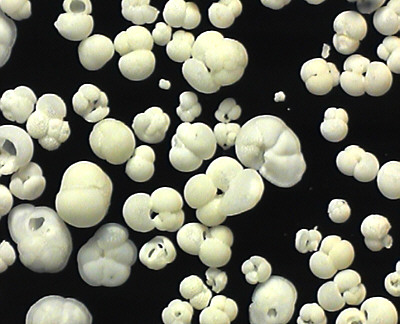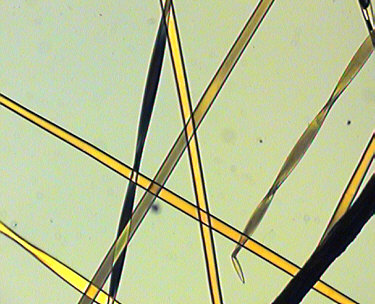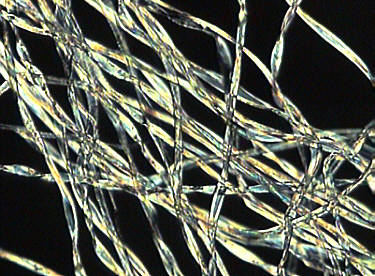Like many enthusiasts of microscopy I've
acquired a modest collection of prepared slides plus vials of
interesting subjects for the microscope. There's a wealth of
excellent books and resources to help interpret both the
microscopic features of the subject, as well as to help
identify the slide maker or mounter.
Investigating the wider aspects of an unfamiliar microscope subject can also be a fascinating exercise. For example, if a plant section; what does the plant and its flower look like, where does it grow etc. These are aspects that the often tiny section on the slide won't reveal. With the explosive growth of information now offered on the Internet, a potential additional source of information to answer a slide subject query is often just a 'click' away. Especially useful if you're not lucky enough (like the author) to have easy access to a comprehensive library of books.
So I selected three of the more intriguing samples and slides I owned, to see what Internet surfing could reveal about them, and the results are presented below. I hope they are of interest and hopefully illustrate that even a familiar slide or sample can be the start of a fascinating new journey of discovery ... it certainly was for the author!
The author's first 'port of call' before 'surfing' is usually Encyclopaedia Britannica (abbreviated 'EB' below) if more specific books aren't available, as it often puts an on-line search on the right track; especially useful where a wealth of hits comes up. The CD version of 'EB' is very good value now, but the text of the encyclopaedia with links to related on-line resources is also freely accessible at britannica.com.
Following cryptic clues
The first example I knew something about as its generous donator provided some background, but you may acquire samples from various sources with no background and just a cryptic sample label to go on. So assuming the latter was the case ....
'DSDP 237/5-5/60'
That is all it states on the vial of white powder. Fortunately this sample series is well documented and 'EB' has an index reference for 'DSDP' which stands for 'Deep Sea Drilling Project' and involved the drilling vessel 'Glomar Challenger'. So already the sample takes on an exciting new light; this powder once rested somewhere deep in the sediments of an ocean floor!
A sample taken by the drilling vessel 'Glomar Challenger' from the Indian Ocean floor. Assuming no prior knowledge of the sample, the Internet can reveal a wealth of information just using the sample code in a search. (Video still macro image using a 50mm SLR lens and extension tubes on a 'C' mount video camera). Horizontal field ca. 4.8 mm. I believe the sample shows foraminifera and possibly other organisms (any comments on identifying them appreciated). |
|
So what does the Internet reveal? An on-line article 'Scientific Ocean Drilling: An American Success Story' by Roger Larson gives an excellent overview. 'DSDP' in Altavista's search engine provides many leads and the first listed hit was a 'bullseye' - a link to the official web site of the 'Ocean Drilling Programme' of which the 'DSDP' forms part. This web site provides an absolute wealth of information on the projects past and present, the samples, and even a virtual tour around the current drilling vessel the 'JOIDES Resolution'! An on-line world map showed 'DSDP leg 237' was a drill site in the Indian Ocean NE of Madagascar. ('60' in the sample code is the depth in meters of the sample sediment beneath the ocean floor).
Many 'DSDP legs' have been catalogued on-line but apparently not '237' to date. So trying a more subtle 'Boolean' search string 'DSDP NEAR 237' on Altavista came up with other sites, and illustrates how a variety of resources can be helpful.
This search gave a link to a bookshop specialising in Indian science books with a volume entitled 'Contributions to XV Indian Colloquium on Micropaleontology and Stratigraphy' with paper 25 on 'Miocene deep-sea benthic foraminifera and bottom waters at DSDP site 237, central Indian Ocean' by Ajai K. Rai and M.S. Srinivasan. Another link was to a fascinating on-line essay 'Dinosaur Extinction: Volcano-Greenhouse Theory' by Dewey McLean of 'Virginia Tech', US where the samples from DSDP leg 237 are mentioned as one of a number that provided evidence of global warming at the so-called K-T extinction.
This on-line 'investigation' took less than five minutes, but provided many cached web pages for off-line reading on wider aspects of the sample and the fascinating drilling project; as well as coming back full circle to providing book titles and papers that if needed could be ordered if the sample was of deeper interest.
So, if you have some cryptically labelled slides or samples in your collection, see how you get on with an Internet search! A well documented third party sample code, or named sample site as keywords in a search may reveal a wealth of info' on-line.
What's in a name?
For some plant or animal subjects on slides, suitable books to hand or large encyclopaedias will often provide details and perhaps images of its wider aspects away from microscopy. But many slides can be of exotic or unusual species and unless you have ready access to comprehensive books on world fauna and flora, pursuing investigations further can be difficult if not time intensive.
It's these sort of slide subjects where the Internet can really show its worth. Almost any plant or animal genus and often species name typed into a web search engine will provide a few if not a wealth of 'hits' - if it's animal, vegetable or mineral there may well be some enthusiast or institution somewhere studying, photographing, breeding/growing or even selling it! Here are two plant examples ...
Sugar Bush Protea repens.
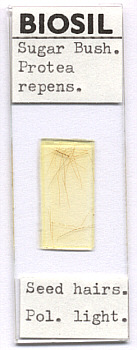 This is a slide of
the plant's seed hairs particularly for polarised light. 'EB'
and other off-line resources gave a 'flavour' of the genus Protea.
So what does the Internet reveal on the plant?
This is a slide of
the plant's seed hairs particularly for polarised light. 'EB'
and other off-line resources gave a 'flavour' of the genus Protea.
So what does the Internet reveal on the plant?
An Altavista search gave a wealth of hits both for Protea repens, the genus Protea and for the common name. To illustrate the breadth of on-line material for many plant and animal species, these are a few interesting links found just for this plant genus/species.
University of California, Santa Cruz 'Arboretum Gallery' has a splendid selection of images showing some of the plants of this genus including P. repens (an attractive small evergeen shrub).
Protea repens, plant of the month - an article on the Univ. of Melbourne, Burnley (horticultural) College's web site which provides an illustrated overview of the plant's features, native growing area (tip of S. Africa) and garden cultivation.
The South African 'Fine Bush' web site describes and illustrates the beautiful 'fynbos' (Afrikaans for 'fine bush') vegetation at the tip of the 'Cape' of which Proteas form a distinctive part. Apparently this small region is a botanist's paradise; the region supports 8500 plant species, 5000 of which are unique to this area.
Protea repens seed hairs between
partly |
|
Sea Island Cotton
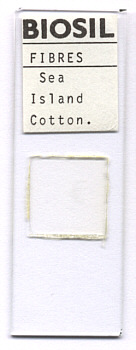 An attractive
subject for crossed polars, but where is 'Sea Island' and
what is so special about its cotton? My unfamiliarity with
this cotton type will suggest to readers 'in the know' that
I'm not buying my clothes in the right places - read on to
learn why! A large atlas indexed two entries for 'Sea
Island', one on which Vancouver airport stands didn't sound
like 'cotton country', but the other off the coast near
Brunswick, Georgia, USA sounded more promising. (Sea Island
itself is one member of the chain of Sea Islands along the US
east coast). 'EB' has an entry for the 'Sea Islands' and
states that 'the fine long-stapled Sea Island cotton was
developed in the islands'. So this cotton is special, but
why?
An attractive
subject for crossed polars, but where is 'Sea Island' and
what is so special about its cotton? My unfamiliarity with
this cotton type will suggest to readers 'in the know' that
I'm not buying my clothes in the right places - read on to
learn why! A large atlas indexed two entries for 'Sea
Island', one on which Vancouver airport stands didn't sound
like 'cotton country', but the other off the coast near
Brunswick, Georgia, USA sounded more promising. (Sea Island
itself is one member of the chain of Sea Islands along the US
east coast). 'EB' has an entry for the 'Sea Islands' and
states that 'the fine long-stapled Sea Island cotton was
developed in the islands'. So this cotton is special, but
why?
What does the Internet reveal? A search revealed many hits and even a web site called http://www.seaislandcotton.com (under reconstruction 12th April). This and other sites sang the praises of the cotton (and opportunities to buy products) but many aspects of the fascinating history of the cotton and its cultivation were also offered, (follow 'history' link on above site, also see 'The legend of Sea Island cotton'. This cotton (Gossypium barbadense) is a long-staple type. 'Staple' is the average length of the fibres and apparently Sea Island cotton is one of the highest quality cottons from which fine fabrics and high quality clothing are made.
Sea Island cotton fibres between crossed polars. Objective 9x, no eyepiece. |
|
Another aspect of following up microscopy subjects is the unanticipated interesting leads they can suggest. Researching the three slides above led to web sites with enthralling reading on topics such as deep sea drilling, history of the Sea Islands and 'virtual explorations' of the 'fynbos' area of South Africa where P. repens is native.
So if you haven't tried the Internet for researching slide subjects or samples for the microscope, I hope the above examples from the author's own collection illustrates that the 'Web' can be a very valuable source of information and enjoyable to use for research.
Perhaps I should end by adding that I also enjoy the tactile pleasure of using books that 'Net surfing' can never replace, browsing round large libraries, the musty smell of secondhand bookshops and that chance book 'find' ... but the 'Net' is a complementary and powerful addition to these resources!
Comments to Dave Walker welcome.
Acknowledgements
Thanks to Richard Howey who donated a splendid set of samples
to the author, one of which is the 'DSDP' sediment described.
Thanks also to John Wells of 'Biosil' who made the 'Sugar
Bush' and 'Sea Island Cotton' slides above. Thanks to all the
individuals, companies and institutions who share their
interests and expertise to compile the information on the web
sites linked to above.
Other Micscape
articles
Brian Darnton in his recent Micscape article 'The
investigation of a microscope slide' also demonstrates how useful the Internet
can be in supplementing book resources and in quickly
tracking down information on a slide maker/mounter.
Microscopy UK Front Page
Micscape Magazine
Article Library
© Microscopy UK or their contributors.
Published in the April 2000 edition of Micscape Magazine.
Please report
any Web problems or offer general comments to the Micscape Editor,
via the contact on current Micscape Index.
Micscape is
the on-line monthly magazine of the Microscopy UK web
site at Microscopy-UK
